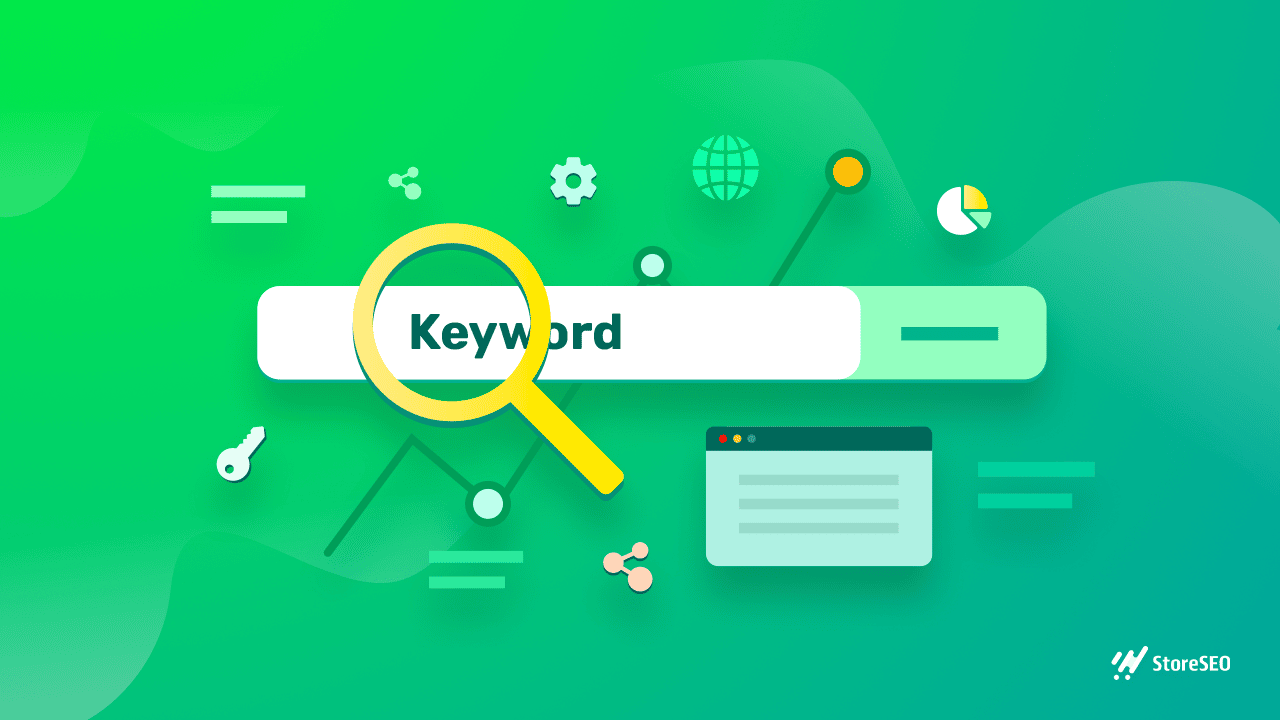Shopify SEO について最初に知っておくべきことの 1 つは、適切なキーワードを使用して商品をランク付けする方法を学ぶことです。結局のところ、すべての潜在顧客は、希望する商品やサービスを探すために特定の検索語を入力します。そして、そのときにあなたのストアが結果ページの上部に表示されるようにしたいはずです。
では、どのキーワードを使用すればよいのか、どうすればわかるのでしょうか?このガイドでは、 Shopifyのキーワード調査 適切な検索用語をターゲットにすることで、オンライン ビジネスへのトラフィックを簡単に増やすことができます。
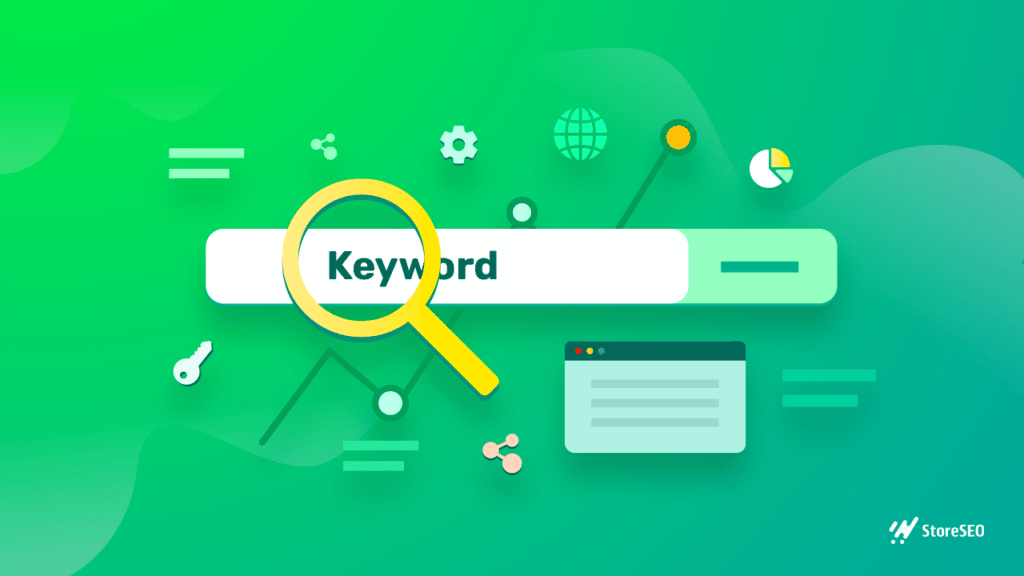
電子商取引におけるキーワードリサーチが重要な理由
電子商取引 SEO の基本的な基礎の 1 つは、キーワード リサーチの方法を知ることです。これは、SEO の基本的な原則が、ユーザーが特定の検索語を使用して製品を検索したときに、検索エンジンが適切なコンテンツやリンクを見つけて表示できるようにすることであるためです。
言い換えれば、手作りのソイワックスメルトを販売するビジネスを営んでいる場合、潜在的な顧客は次のような検索語を入力する可能性があります。 「動物に優しいワックス」 または 「オーガニックワックスメルト」。 あなたの目標は、顧客が最も使用する可能性の高いキーワードの検索結果ページの上部に、あなたの製品とストアが表示されるようにすることです。
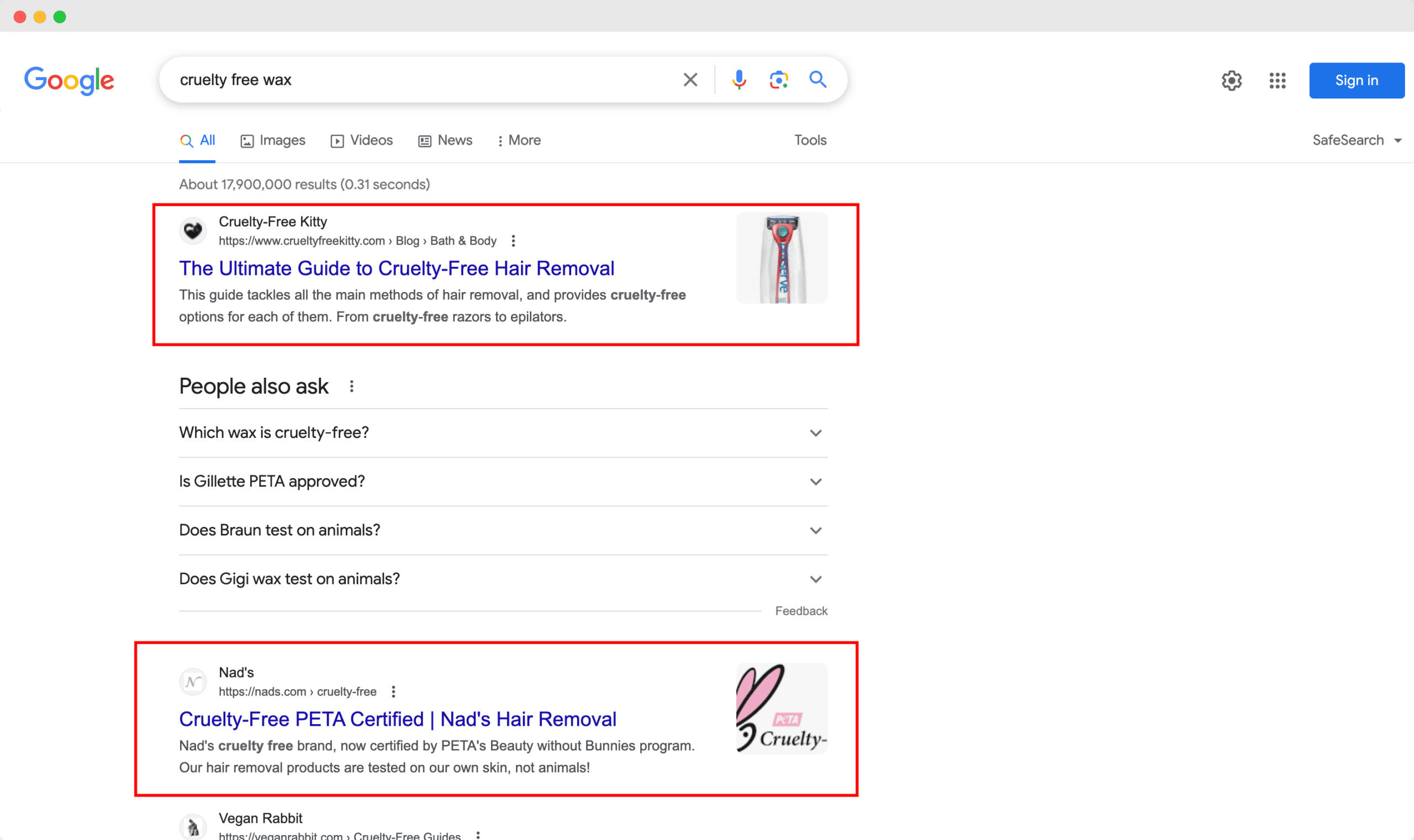
では、どうすればいいのでしょうか? 答えは、キーワードリサーチの方法を知ることにあります。
電子商取引ストア向けキーワード調査の基礎
さて、Shopify ビジネス向けのキーワード リサーチを行う場合は、まず、どのキーワードを選択すべきかを理解するのに役立つ基本的な指標をいくつか理解しておく必要があります。以下は、知っておく必要のある最も一般的なキーワード リサーチ指標の一部です。
検索ボリューム: 最初に知っておくべき指標は、キーワードの検索ボリュームです。名前が示すように、これは特定のキーワードが特定の期間に何回検索されたかを示します。一般的に、検索ボリュームが高いキーワードは、その検索用語が潜在顧客によってよく使用されていることを示しています。
ただし、注意してください。検索ボリュームだけに基づいてキーワードを選択しないでください。検索ボリュームが高いほど望ましいですが、キーワードが自分の提供しているサービスに関連しているかどうかも自問する必要があります。
さらに、そのキーワードで上位にランクインするために直面する可能性のある競争の量など、他の要素も考慮する必要があります。これについては後ほど説明します。
競争: 前にも述べたように、特定のキーワードで商品を上位にランク付けするには、どの程度の競争に直面する必要があるかを知る必要があります。Shopify のキーワード リサーチを行うときは戦略的に行う必要があります。競争が激しすぎるキーワードを選択すると、検索結果ページで表示される可能性が低くなるだけだからです。
有料難易度: これは上で述べた指標と多少似ていますが、この場合は、特定のキーワードを使用して有料広告でストアがランク付けされるのがどの程度難しいかを測定することになります。
クリック単価: これは、有料広告を使用して特定のキーワードでランク付けするためにかかる費用を示します。表示される金額は、顧客が検索結果ページで広告をクリックした場合に支払う必要がある金額です。
ガイド: Shopify ストアのキーワード リサーチを実行するにはどうすればいいですか?
ShopifyにはSEOのための独自の組み込み機能がありますが、Shopify製品のキーワード調査を簡単に実行して最適化したい場合は、 ストアSEOこれは、検索結果ページの 1 ページ目に e コマース ストアをランク付けするのに役立つ多数の機能を備えた、Shopify 向けの高度なオールインワン SEO ソリューションです。
![How To Do Keyword Research For Shopify Using StoreSEO? [2025]](https://storeseo.com/wp-content/uploads/2022/07/image-11.png)
StoreSEOの多くの重要な機能の1つは 高度な「キーワード分析」機能では、顧客をターゲットにするために使用できる適切な検索用語をすばやく検索できます。以下では、StoreSEO を使用して e コマース ビジネスのキーワード リサーチを実行するために使用できるステップ バイ ステップのチュートリアルを共有しています。
ステップ1: ShopifyストアにStoreSEOアプリをインストールする
まず、Shopifyストアに商品、ページ、その他の必要な詳細がすでに設定されていることを確認します。それが完了したら、Shopifyアプリストアにアクセスして StoreSEOアプリをインストールする.

アプリをインストールした後、eコマースビジネスに関する情報を追加し、StoreSEOを設定するように求められます。詳細については、完全なガイドをご覧ください。 StoreSEOをここから始めましょう.
ステップ2: StoreSEOでキーワード分析を設定する
次に、StoreSEOダッシュボードに移動し、SEOを最適化したい商品を選択します。 '修理' 下図のようにボタンをクリックすると、製品を最適化するための適切なキーワードを検索できる新しいページにリダイレクトされます。
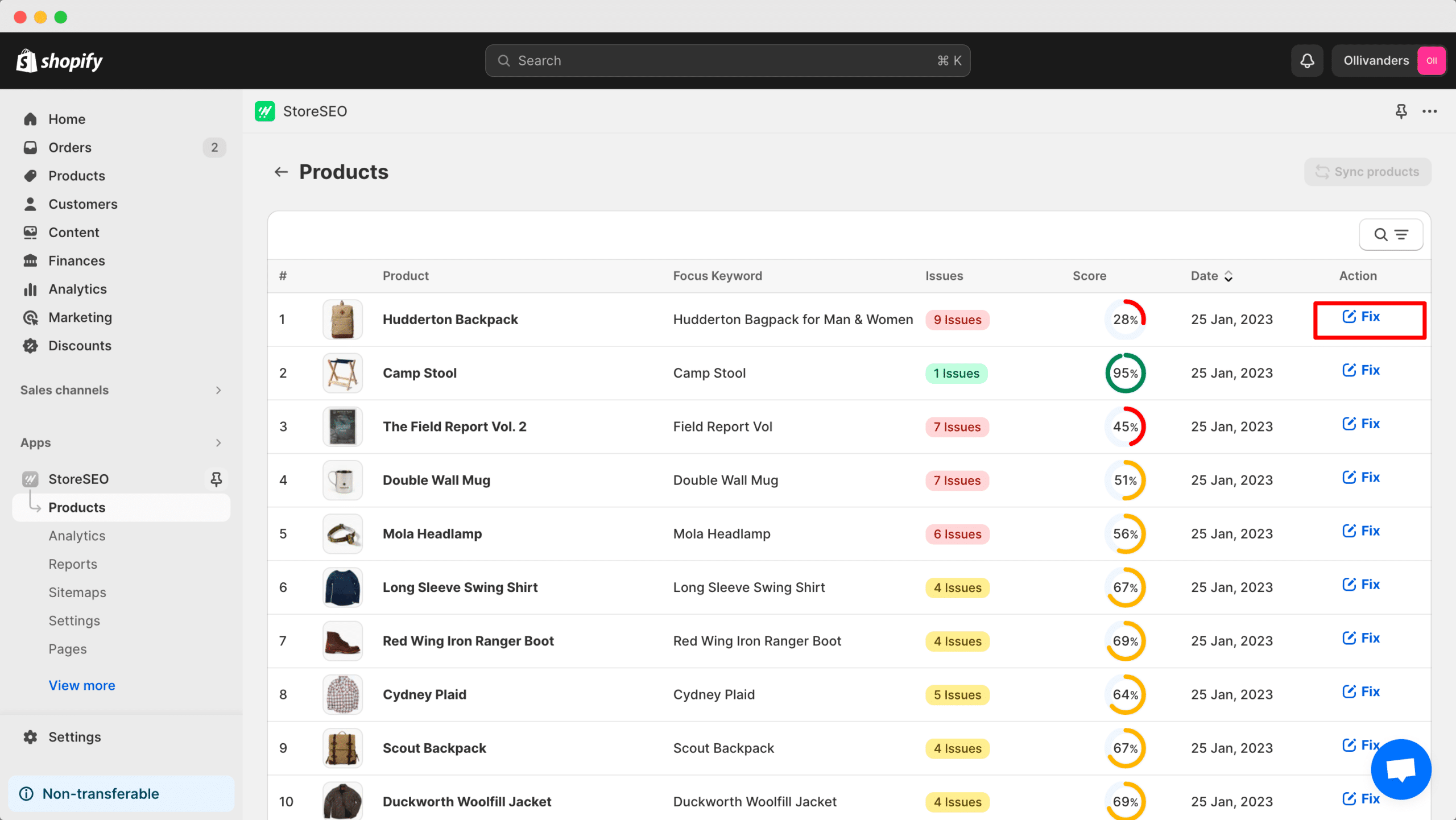
ここからが楽しい部分です。ここでStoreSEOが提供するものを見ることができます 詳細なSEO修正手順 最高の SEO プラクティスで製品を最適化するために従うことができる内容です。また、これらの手順の多くには、製品の説明、メタ説明、製品ページのタイトルなどにキーワードを追加するなど、キーワードの使用が含まれていることに気付くでしょう。
しかし、どのキーワードを使用すればよいのでしょうか?
そこでStoreSEOの 「キーワード分析」 機能が登場します。製品に関連するキーワードを入力し、 「キーワード分析」 ボタンをクリックして、このキーワードがあなたのビジネスやターゲット顧客にとって役立つかどうかを確認してください。
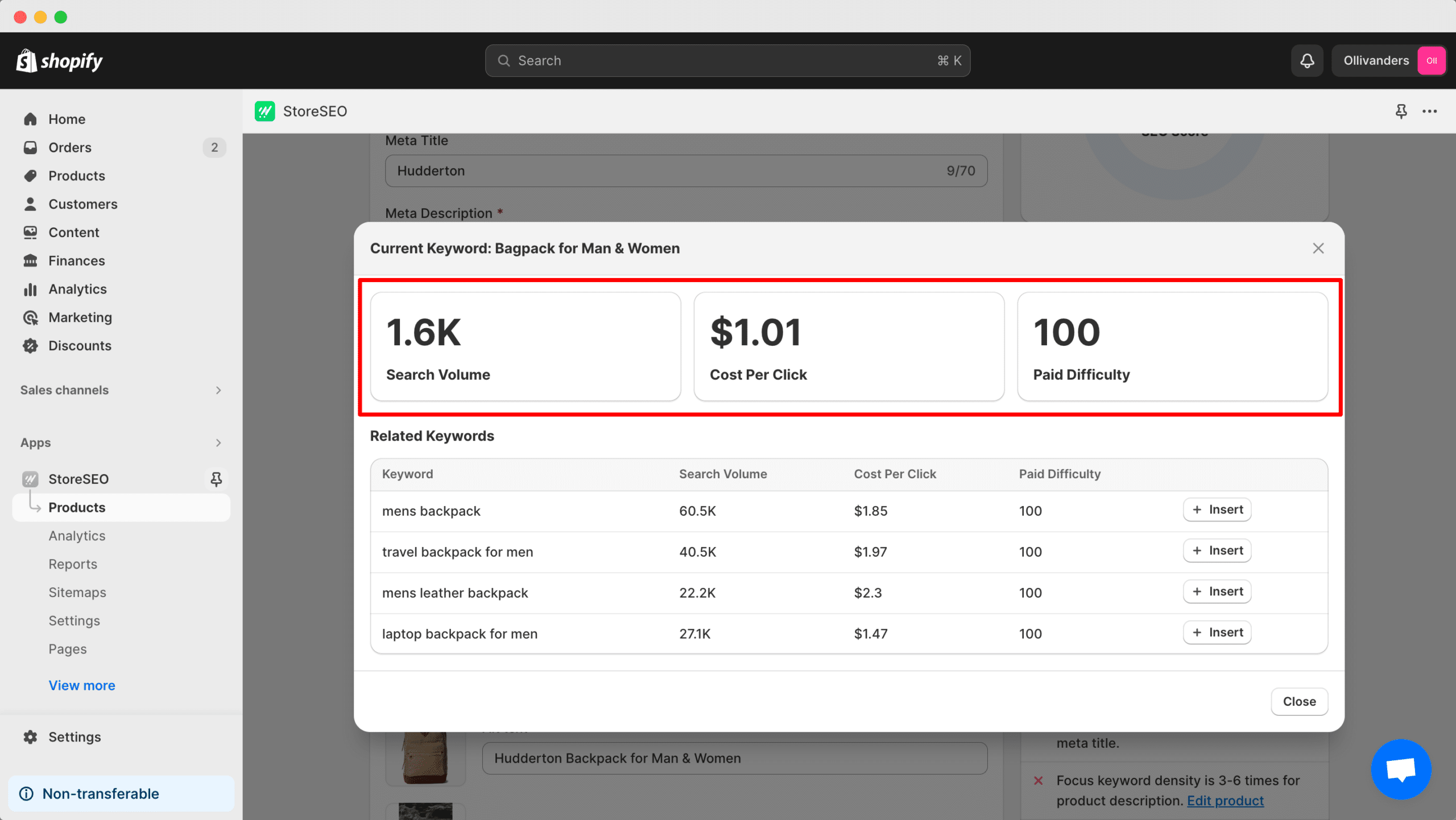
入力したキーワードについて、StoreSEO は、そのキーワードを製品に使用するかどうかを判断するのに役立つ最も重要な指標をいくつか表示します。焦点となるキーワードを入力するときは、SERP で簡単にランク付けできるようにロングテール キーワードを使用するようにしてください。
これらには、 検索ボリュームは、そのキーワードがユーザーによって何回検索されたかを示します。 クリック単価(CPC)は、顧客がそのキーワードの広告をクリックした場合に支払う費用を示します。 有料の難易度これにより、有料広告の検索結果ページで自社の製品が上位に表示されるのがどの程度難しいかがわかります。
これらに加えて、StoreSEOは、商品を最適化するために使用できるいくつかの関連キーワードも表示します。 1つの焦点キーワード ストアを最適化するには、関連キーワードをタグとして使用して、顧客がそれらの検索用語でも商品を見つける可能性を高めることをお勧めします。
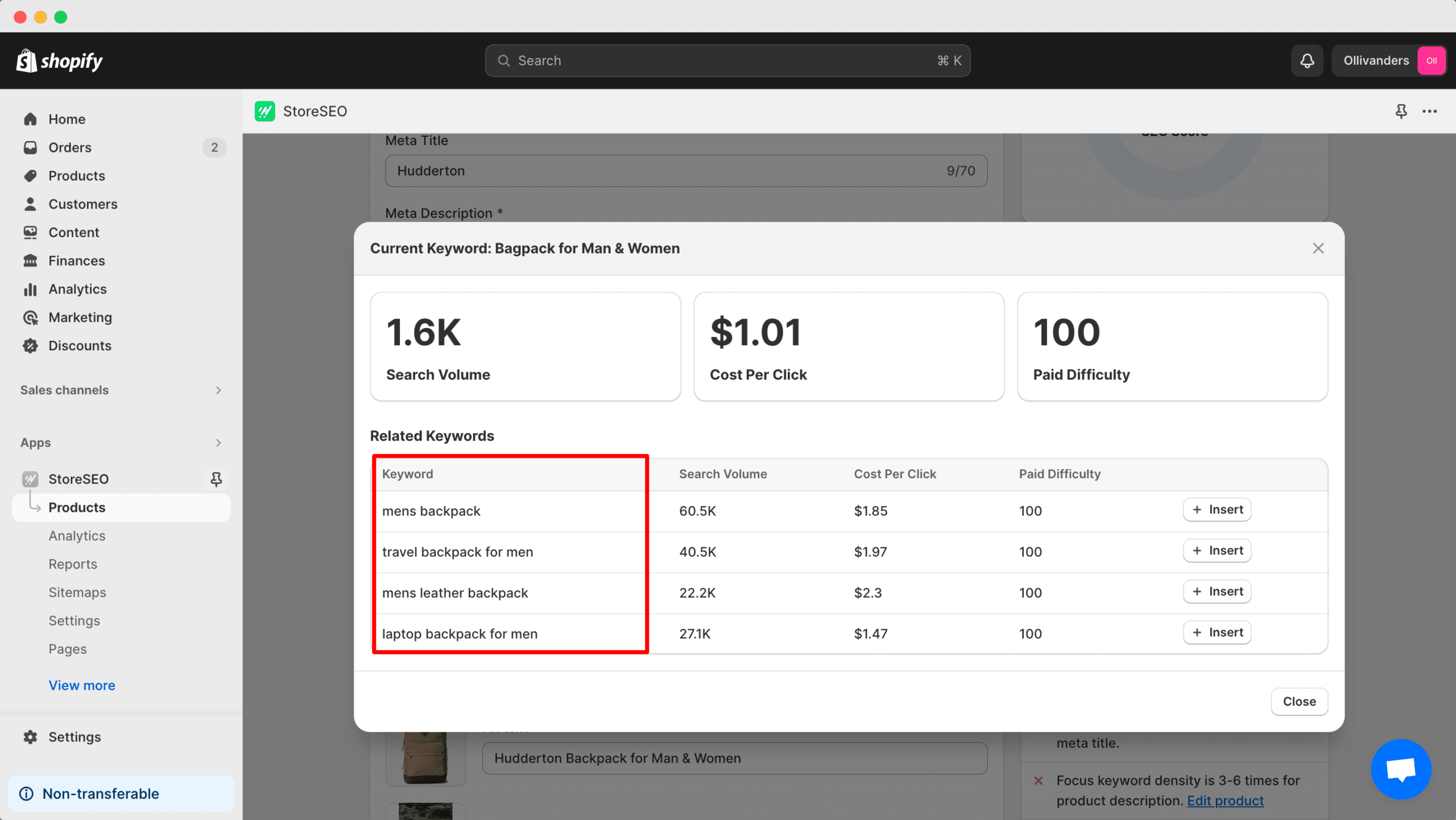
ステップ3: SEOのために製品やページを最適化する
StoreSEOの助けを借りてどのキーワードを使用するかを決めたら キーワード分析 機能の導入後は、適切な SEO プラクティスを使用して Shopify ストアを最適化する必要があります。
前述のように、StoreSEO は詳細な SEO 手順を提供し、これらの手順に従って製品、ページ、またはコンテンツを更新するたびに SEO スコアが向上します。
このように、StoreSEO を使用すると、いくつかの簡単な手順で Shopify のキーワード リサーチを非常に簡単に行うことができます。ぜひご自身で試して、StoreSEO の助けを借りて、オンライン ビジネスにトラフィックをいかに簡単に誘導できるかを確認してください。
ボーナス: Shopify ストアを 1 ページ目にランク付けするための究極の SEO チェックリスト
StoreSEOのようなShopify SEOソリューションを使用すると、検索結果の1ページ目にランクインする際に確実に優位に立つことができますが、ShopifyビジネスをSEOに最適化するために必要なすべての手順に精通していることも重要です。その手助けとなるように、 究極の SEO チェックリスト これにより、ビジネスをトップにランク付けし、コンバージョンを簡単に向上させることができます。
この投稿を気に入っていただけましたか? ブログを購読する もっと楽しいチュートリアルをご覧になりたい方は、フレンドリーな Facebookコミュニティ.


